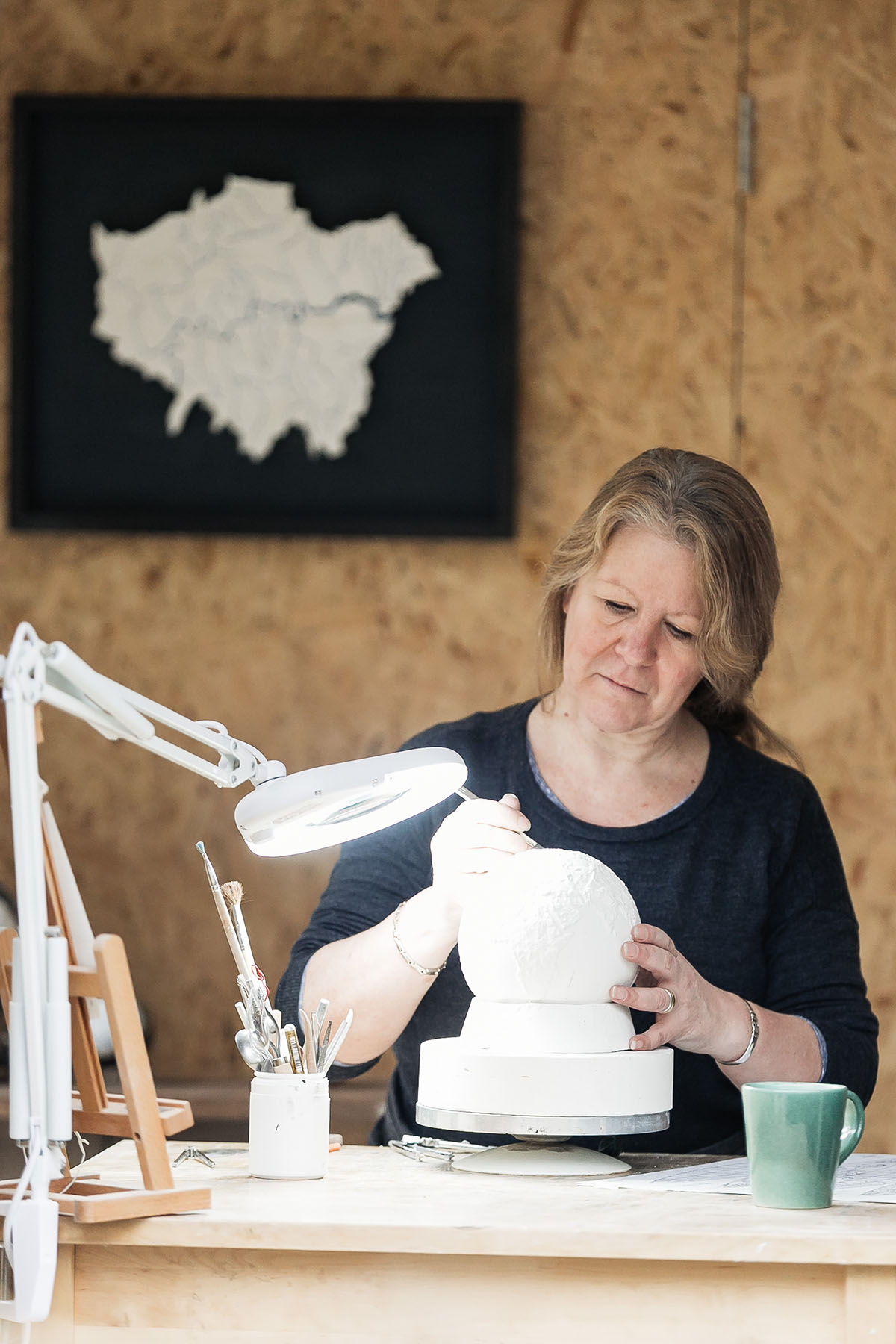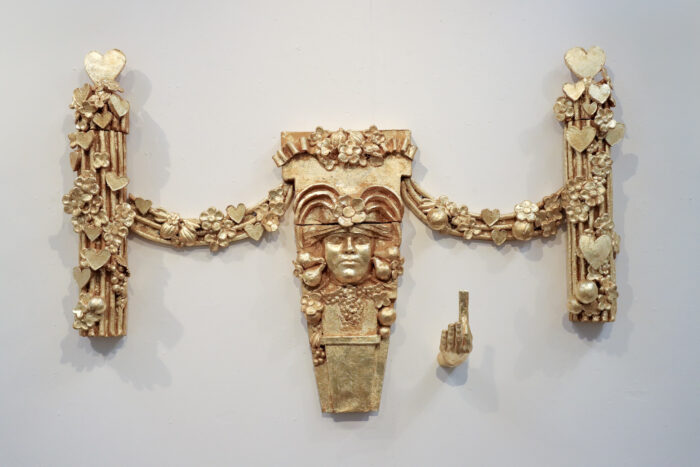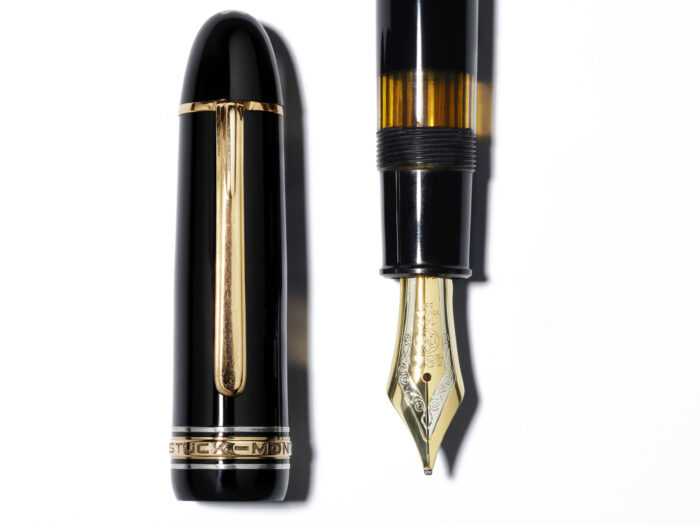Maker in Focus: Loraine Rutt

In this month’s Maker in Focus interview, we spoke to ceramic globe maker Loraine Rutt on being inspired by historic cartographers, creating a moon globe for an Apollo 15 astronaut, the importance of collaboration, and her advice for aspiring craftspeople.
LCW: What does your typical day look like?
LR: Often I wake quite early and the quiet stillness allows the better of my creative thoughts to filter to the top. I’ve learnt not to worry about making notes and sketches in the wee small hours as I think the good ideas will hopefully stick around.
By mid-morning it’s generally studio time. There’s a lot of different stages to making the globes and cases, so I tend to work in small batches, making 4 or 5 globes one week, and a similar amount of cases another.
The larger wall pieces like the Segment series involve quite an intense amount of focus. The first edition took take around a thousand hours to model the 24 relief segments to scale in wafer-thin porcelain layers.
On the rare occasion I stop for lunch it’s a treat to sit with my lovely neighbours in our courtyard at the Arches Studios. Most days are at least 12 hours, but when you thoroughly enjoy your work it tends to fly by.

LCW: What initially led you in to craft as a career?
LR: It was a sideways step really. I’d always loved maps so when I’d just left school aged 16 and saw a job as apprentice cartographer at Birkbeck College I leapt at the chance. Both my primary and secondary schools had brilliant teachers who embraced art and craft and I was lucky to work with clay from about the age of 9. Whilst I loved drawing maps I knew I was happier making things so did some evening classes at Putney School of Art where Esperanza Romero was teaching. She was really complimentary about what I was making and talked about the ceramics degree she had recently completed. I applied to Central (St Martin’s) and to my joy I got in! It was a life changing experience.
LCW: What role does craftsmanship and making have in society?
LR: Room for creativity has been sadly squeezed from the curriculum, but it is so very important. Not just for sowing the seed for budding artists and makers, but for all careers. The problem solving and inventiveness required when working with materials can give children, and adults the confidence to flourish in other areas too. Thankfully the education sector is starting to realise this, and there is a move, starting from the ground up, to factor in more time and budget for art and making.
LCW: What are the positives and negatives about being a craftsperson?
LR: ‘Expect the worst and hope for the best’ is my approach in the studio. Being a craftsperson, working in my own studio is mainly a positive experience, I enjoy the freedom of making what I want to make, and experimenting, although there are moments when the ‘expectations’ unfortunately get the upper hand. I spent a long time (over two years) trying different ways to make the pocket globes and the cases, with many disappointments along the way, but when I started to get the results I was seeking, everything just came together.
It’s a positive joy collaborating with other craftspeople. I work with wood turner Richard Findley, a specialist box maker Tom Aylwin, and gilder Gary Gronnestadt. Mia of Sabel Saddlery taught me how to make the bespoke leather covered cases.
On the negative side, the hours can be tough, I left a 9-5, 5 day a week job 30 years ago and now I do 9-9, 7 days a week. It is immensely satisfying though being able to play a part in the giving of bespoke gifts. I get to travel vicariously through commissioned globes, and share a small part in the gift giving. The first ever order for a bespoke globe placed on my website asked for an inscription ‘Jacqui – Marry Me?’ I was slightly nervous at making the carrier of this important message. I was delighted to receive the news that Jacqui said yes.

LCW: What are you most proud of?
LR: There’s been a few self-pinching moments recently, one of which was showing my tiny Moon Globes to an Apollo 15 astronaut that had been there and mapped 75% of the lunar surface. When I met him again a year later he told me that he loved my work, kept my globes on his desk, and asked if I would be interested in doing a limited edition. So this year sees the launch (pardon the pun) of The Al Worden Lunar Globe commemorating 50th Anniversary of the Lunar Landings.
Another highpoint last year was being commissioned by The National Maritime Museum to make a Pocket Globe for their permanent collection. And I’m chuffed to bits to have been asked to lend my Peckham Postcard series, which charts the disappearance of the River Peck to The Museum of London for their Secret Rivers exhibition in Docklands this summer.

LCW: Who or what inspires your work?
LR: Not one thing or person, but indeed many. I was lucky to have been taught by inspirational ceramicists at Central. Richard Slee’s work is so immaculately made, original, and with such a wry wit it never fails to make me smile. Eileen Nisbett and Gillian Lowndes were both pioneers of pushing the medium in very different directions and were incredibly generous teachers.
Some of my edition pieces are hat-tipping acknowledgement to inspirational historic cartographers. The finesse and incredible level of detail contained within maps never ceases to inspire me. Emery Molyneux travelled with Drake on his second circumnavigation of the globe in 1577-80 then made the first English Globes, one of which survives at Petworth House, and another in Middle Temple. Social geographer Charles Booth mapped the social status of every inner London house in the 1890’s, and by doing so highlighted the extent of poverty in city. I have some experimental work in progress at the moment for some geology pieces inspired by William Smith, who single handedly and pretty correctly drew the first geological map of the UK; Marie Tharp who drew the first maps of the ocean floor; and Phyllis Pearsal who walked the entire streets of London to map the A-Z.
LCW: What is the one piece of advice you’d give to an aspiring craftsperson?
LR: Go and look at as much craft as possible, and keep an open mind about what you’d like to make and try as many materials as you can. Make the most of London Craft Week and also sign up for newsletters from The Crafts Council, there are many workshops to take part in. Trust in your own ability to make original work. If you are interested in being a maker then it is just a matter of research, practice and time and following your heart.
Website: www.thelittleglobeco.com
Instagram: @the_little_globe_co


